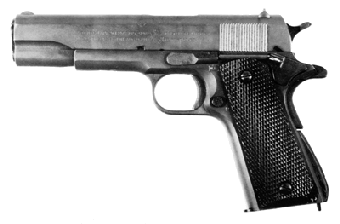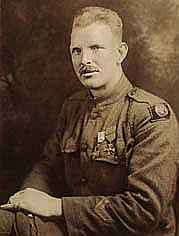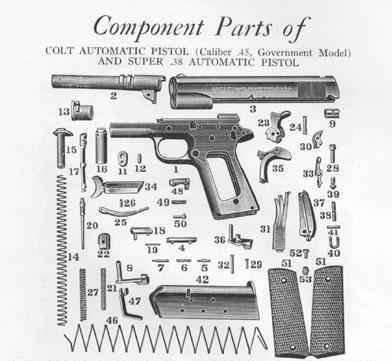The Story of the American Expeditionary Forces |

Ordnance Branch Insignia |

THE AUTOMATIC PISTOL
|


On the morning of 8 October 1918, elements of the 328th Infantry, 82nd Division, United States Army, were pinned down by German machine-gun fire. Seventeen men, under the command of Sgt. Bernard Early, were ordered to out-flank the machine guns. |

Sgt. Alvin York
|
Shortly after they left their own lines, they came across a German officer and several soldiers having breakfast. Believing that they were surrounded, the Germans surrendered. However, before Early could detach a man to take the prisoners back through the lines, intensive machine gun fire swept the patrol. Eight American soldiers survived. Sgt. Early was seriously wounded. As the remaining non-com, Cpl. Alvin York took command of the patrol. While the remaining Americans covered their prisoners, trying at the same time to avoid enemy fire, York spotted the location of the German guns, about 30 yards away. In addition to his Model 1917 Enfield rifle, he also carried a Colt .45 automatic pistol. The German gunners peeked over the tops of their Maxim guns to avoid hitting their own men. |

Lt. Frank Luke
|
After destroying the third balloon, Luke was wounded and his Spad was so shot-up that he could barely control it. Nevertheless, he maneuvered his airplane to strafe German infantry columns. He crash-landed and was immediately surrounded by Germans. Rather than surrender, he drew his .45 automatic pistol and started firing at the Germans. They returned his fire, killing Luke immediately. Frank Luke was awarded the Medal of Honor posthumously.
John Browning was born in 1855, son of a gunsmith, in Ogden, Utah. His rifles, pistols, machine guns and shotguns have dominated the field of fire arms for almost 100 years. It was in 1896 that John and his brother, Matthew, approached the Colt Firearms Company in Hartford, Connecticut. They reached an agreement for Browning to work with Colt as an independent designer of firearms. For the first 15 years, they developed probably the most enduring firearm in military history: the Government Automatic Pistol, Caliber .45. Browning and Colt worked closely with the U.S. Army Ordnance Department. Models were field tested by active-duty soldiers, and extensive laboratory tests were made. Soldiers stationed in the Philippines reported that the .38 caliber pistol then in use was almost useless against the hard-charging Moros. These tribesmen wrapped themselves in tough leather bindings. Swinging their razor-sharp Kris like a windmill, their bodies absorbed two, three or four shots. On reaching the line of U.S. soldiers, they usually managed to kill one or two soldiers before the .38 shots had their effect and they fell in battle. The soldiers wanted more impact; more stopping power. In addition to reports from the field, the ordnance department made tests with various cartridges and loads. In order to develop a pistol with the greatest impact possible, studies were made by firing into soft wood, clay, carcasses of animals, human cadavers, and live animals. A look at the ballistics of the Colt .45 and the Parabellum (Luger) 9 mm cartridge highlights the basic differences of these cart ridges.
The Colt .45 bullet is a big, slow-moving projectile. When it strikes a target, a great deal of energy is transferred from the bullet to the target. This provides the "knock-down" quality for which the gun is so famous. Officially adapted by the U.S. Government in 1911, production proceeded at a slow pace. Peace-time budgets are never very large. |

See Key Below
|
When the United States entered the Great War, there were about 60,000 Colt .45s on hand. The bulk of them had been manufactured by Colt, with a few thousand manufactured by the U.S. Armory at Springfield, Massachusetts.
Guns made for these production runs were all stamped UNITED STATES PROPERTY on the frame. The slide carried the inscription MODEL OF 1911 U.S. ARMY on both Army and Marine Corps issue. Those manufactured for the Navy were stamped MODEL OF 1911 U.S. NAVY until 1915 when they, too, were labelled US Army. Production runs increased when the Great War started and continued to increase through 1918. By May 1918, it had increased to 1,000 per day. The summer months of 1918 saw an increase to 2,200 per day. The vast majority of these guns were produced by Colt or the U.S. Armory at Springfield, MA. Remington UMC produced about 21,000. Plans were made for many other companies to start production of the .45 automatic, but the war ended before they were tooled up for production. Since the number available for the doughboys was less than required, the troops in France were also equipped with the less satisfactory Model 1909 Colt .45 revolver. A number of foreign companies or governments were licensed to manufacture the Colt-Brownings in a variety of calibers. It is interesting to note that Colts at one time were produced under the direction of the Nazi government. In 1915 the Norwegian government was licensed to manufacture the pistols. When Nazi troops occupied Norway in World War II, they ordered the government arsenal to start production. The Nazi's planned to use the pistol to arm their occupying forces. However, only about 1,000 guns were produced in 1941 and 1942. |

Numbers Match Image Above
|
After the Great War, the Army's Ordnance Department evaluated the Colt .45's combat performance. They recommended the following changes: |
|
Sources and thanks: Thanks to weapons expert Sam Lisker of the excellent website, coltautos.com, for the Colt .45 illustrations. An earlier version of this article appeared in RELEVANCE, our quarterly journal. Other past journal articles can be visited by returning to the GREAT WAR SOCIETY homepage. MH |
To find other Doughboy Features visit our |
Membership Information  Click on Icon |
For further information on the events of 1914-1918
visit the homepage of |
Michael E. Hanlon (medwardh@hotmail.com) regarding content,
or toMike Iavarone (mikei01@execpc.com) regarding form and function.
Original artwork & copy; © 1998-2000, The Great War Society